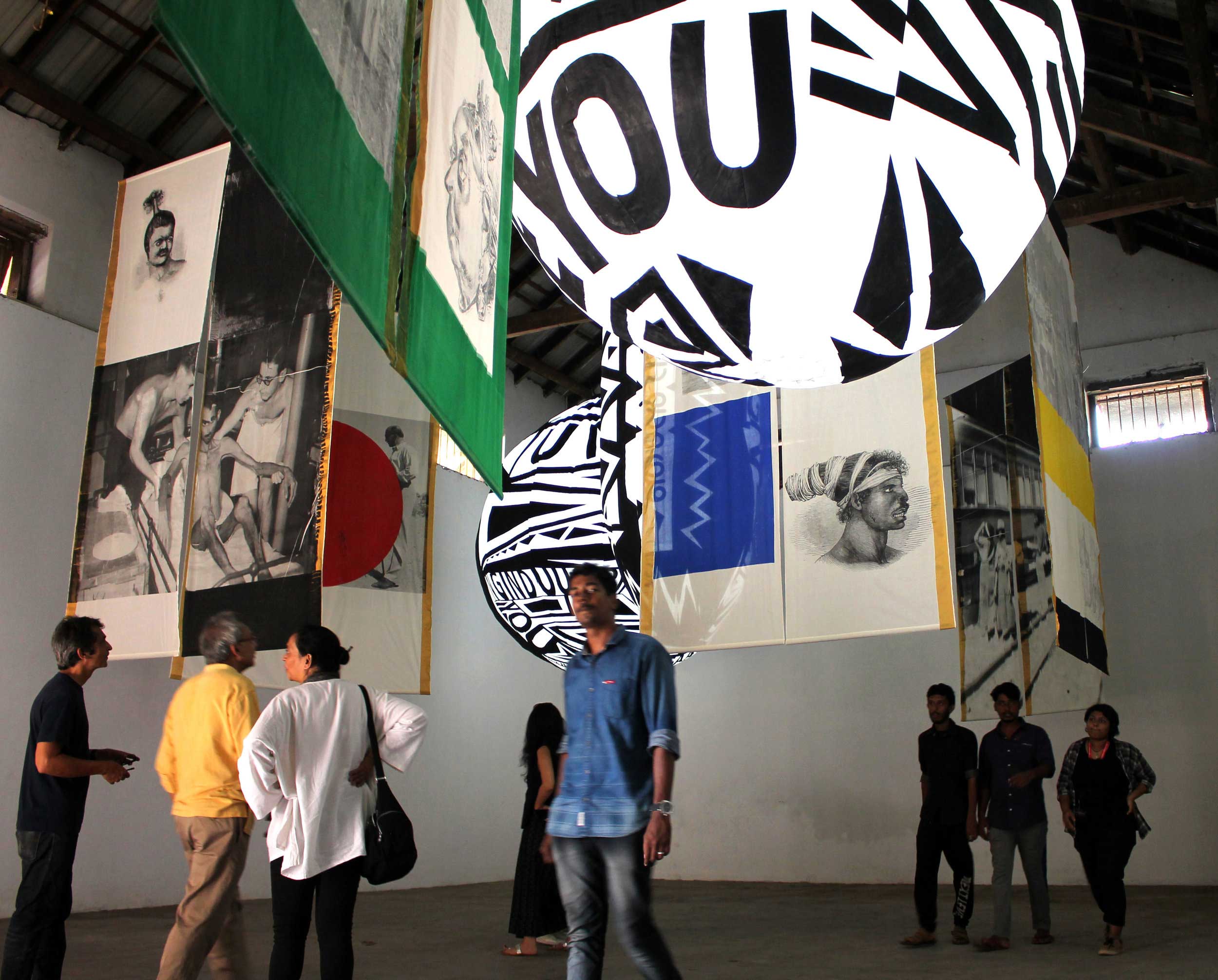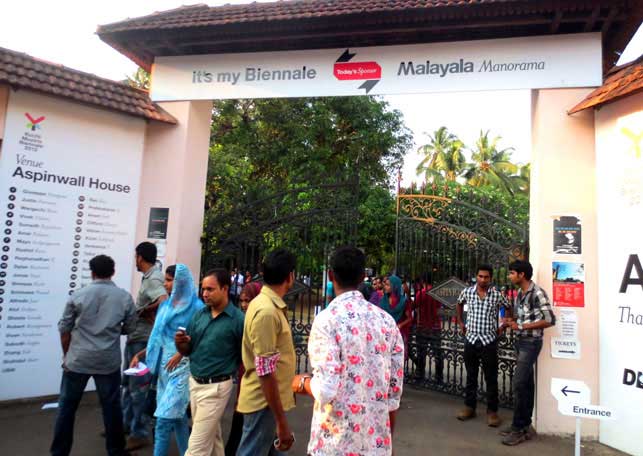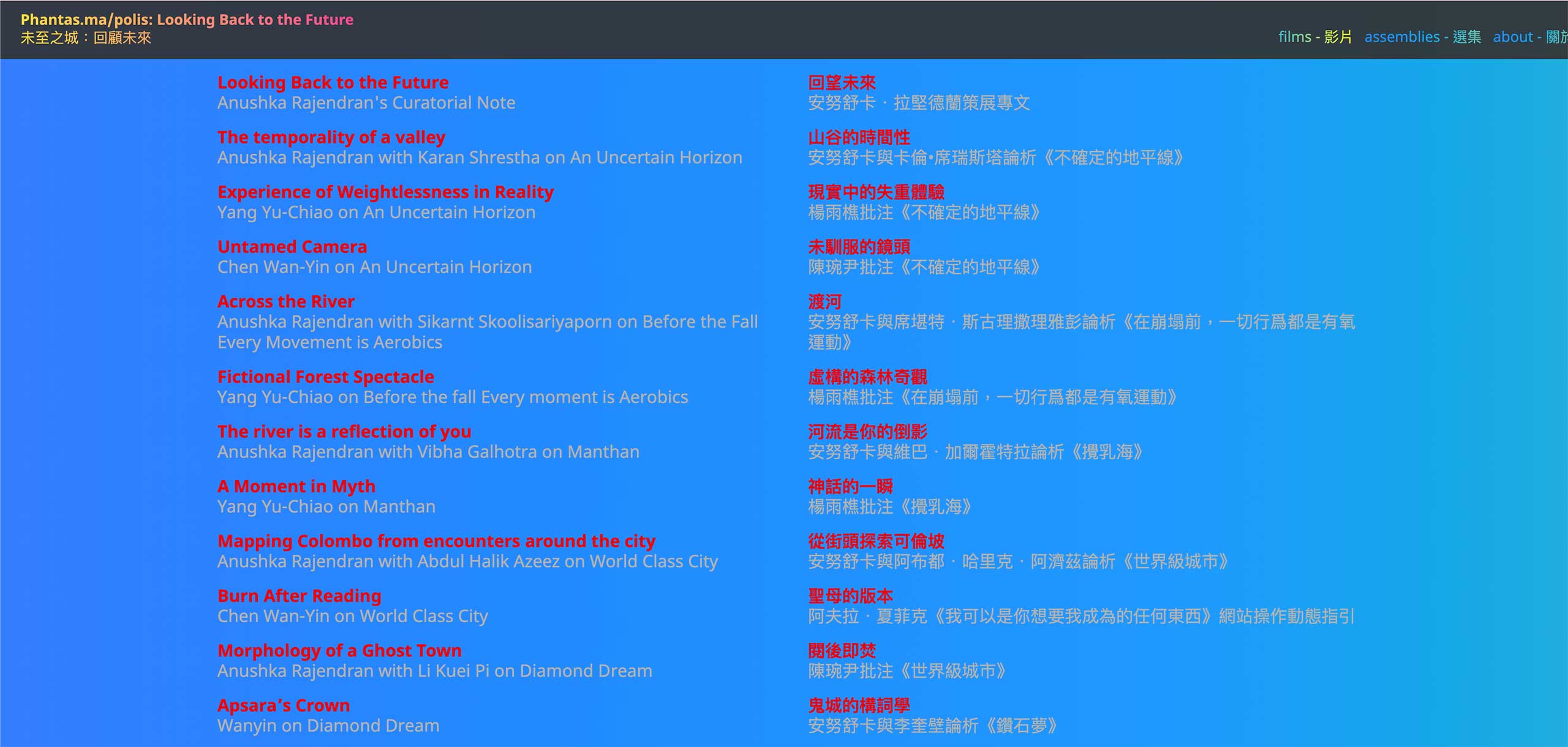Grassroots Curating in Asia
In South Asia, where the figure of the contemporary curator is relatively new, the possible implications and scope of curating are sometimes ambiguous, even to self-proclaimed curators themselves, as well as to institutions and galleries that are sustained by collecting practices. Additionally, there are not enough dedicated, critical graduate and undergraduate programs for curatorial studies, especially when the arts context is sustained by a circuit of commercial galleries that generally view curators as obtuse context-providers for exhibitions they were going to mount anyway. It is perhaps no surprise, then, that the Kochi-Muziris Biennale opted to foreground curatorship exclusively by artists, asserting the notion of artist-curators. After all, it has always been constellations of artists as pedagogues or institution builders who have strived to create critical conversations and vital infrastructures for their peers and contemporaries in this region. While such condition of curating still holds true as I write this in 2024, the art historical continuity to the Kochi-Muziris Biennale conceiving this model several years ahead of its inaugural edition in 2012 is evident. In the early to mid-2000s, artists who had participated in large-scale international exhibitions, often well-traveled and cosmopolitan, were arguably more representative of the socio-economic diversity within the Indian context than many respected curators of the time. They were perhaps best placed to take on the circuitous, multi-faceted responsibilities of what goes into curatorial work in a complex context such as Fort Kochi, which did not present an already existing arts infrastructure that could handle the imaginative demands of its founders, who had also curated the first edition.
The curatorial discourse of the early 2000s was primarily oriented towards engendering transformative shifts in knowledge and pedagogy within the framework of post-colonialism, prioritizing intellectual and educational advancements over the implementing of infrastructural, organizational, or institutional reforms. Among the vanguard of curators practicing during this particular period, notable figures such as Geeta Kapur, revered for her discerning approach as an art critic, and Gayatri Sinha, emerging from a subsequent cohort, have indelibly etched their names in the annals of art history during an era characterized by the scarcity of such transformative contributions.1 While it may be tempting to overgeneralize, it is worth noting that the undertone of professional curatorship during that time was characterized by a tendency to support existing spaces rather than pursue off-sites or alternative institutional positions. In this context, many professional curators acted as delicate diplomats, skillfully navigating between requirements of artists and institutional limits in such ways that no feather was unmanageably ruffled, rather than practicing their ideological positions through working methods or lobbying for institutional reform. This decade also witnessed a wave of survey exhibitions of Indian art at Western institutions and museums, some of which were curated by Indian curators who built exhibitions that attempted to represent the contemporariness of India and consequently Indian art, as apart from the dated orientalist gaze fixed upon the context informed by colonial discourse, largely as a result of the impact of post-colonial theory, which brought forth an urgency to contextualize anti-colonial democracies as ‘other’ and distinct from the West.2 While it was this trend—which was influenced by and conversely sustained projections on the Indian art market—that gave rise to cosmopolitan, globe-trotting, influential artists, some of whom would go on to curate the first few editions of the biennale. Kochi-Muziris Biennale was instrumental in subverting the intent of these exhibitions, thus by-passing the national to integrate itself within an art-world understanding of the Global South.3 The survey exhibitions of Indian art performed “Indianness” for a Western gaze while the artists who were part of these exhibitions were critical of nationalism in their works. As an addendum to this contradiction, until today a majority of the exhibitions in India are by and of Indian artists, and most commercial galleries only represent and show the work of artists from the country. The only notable exception to this in the 2000s lay with the work of artist-run institutions, such as New Delhi-based Khoj and Bengaluru-based 1Shanthiroad Studio/Gallery, which forged solidarity with other arts contexts in the subcontinent. This also lends legitimacy to my earlier claim that deep-seated changes, the inception of vital infrastructure, and the developments of transgressive discursive frameworks have mostly been the consequence of artists working towards these transformations, not necessarily curators.
As indicated by the catalogue texts of these Indian survey exhibitions, the curators tend to claim singular art historical authenticity to their curatorial narratives.4 At the time, their authority was generally unquestioned in the public art circuit, thus failing to acknowledge that they were individuals who could not escape subjective biases, the influence of friendships, and the limits of their knowledge and expertise. While it is now a given that curators are vital for the relevance of their voices, research, perspectives and interpretive cleverness, this was not the case two decades earlier. Kochi-Muziris Biennale, by inviting artists to be curators, also invited artistic subjectivities into curatorial narratives, aligning with the broader shift within curatorial practice. The subjective, intuitive, and affective leaps from one artist’s work to another, seen in various iterations of this biennale, were among the most joyous aspects of my work as a curatorial aide with artist Anita Dube for her fourth edition of the biennale in 2018.5 Jitish Kallat also keenly notes that while working on the second edition, he did not desire to arrive at the exhibition plan with predetermined answers or hypotheses that he wished to illustrate through the works of the participating artists. His interest in history and cosmology became prompts from which he could treat the biennale exhibitions as sites where questions and contradictions could emerge and dialogue with each other, and where thematic formulations could occur in real time during the life of the exhibition.6

Bose Krishnamachari, the founder of the Kochi-Muziris Biennale, attributes the impulse behind institutionalizing the artist-curator to his own experience as an artist. He understands how artists are committed to both artistic processes and site-specificity, making them perhaps the best-suited candidates to envision and realize an international biennial for Fort Kochi, a locale with no prior precedent for such an event. From his early years as an art student and later as an educator in Bombay, he gleaned from the experiences and encounters made possible by the city, which was his classroom and studio, shaping his understanding of his artistic and subsequent curatorial practices. He therefore was interested in similar approaches from artists dedicated to situating such transformative encounters in Fort Kochi. Upon further reflection on the concept of the artist-curator within the specific context of Kochi, one can potentially trace its roots back to Krishnamachari’s tri-city solo exhibition titled De-Curating: India Contemporary Artists (2003). This exhibition, which leads one to assume an antagonistic position early on towards the curatorial, upon deeper engagement reveals a dissatisfaction with the curatorial research of the time.

2 I have further analyzed survey exhibitions of Indian art in my essay: Anushka Rajendran, “International Survey Shows of Contemporary Indian Art,” in 20th Century Indian Art. Modern, Post-Independence, Contemporary (Thames and Hudson, 2022).
While he was a student at the Goldsmiths in London, he saw the exhibition Bombay/Mumbai 1992–2001 (2001) curated by Geeta Kapur (a consistent ally and friend to the Kochi-Muziris Biennale) and Ashish Rajadhyaksha at the Tate Modern, and was dissatisfied by their claims about the city and/or representations of the artistic impulses contained by the city, which, according to him, far surpassed the limits of their curatorial premise. Whether the dissatisfaction was warranted or not is not the concern of these musings, but De-Curating was a response to this, where Krishnamachari presented portraits of 94 artists alongside their biographies, gathered over three years of research and travel, many of whom practiced outside of the radar of curators.7 One cannot help but recall Geeta Kapur’s publication, Contemporary Indian Artists (1978), which treated the biographical as a methodology for critical writing on the practices of five of the most well-known artists from India: Francis Newton Souza, Ram Kumar, Akbar Padamsee, Maqbool Fida Husain, Bhupen Khakhar, and J. Swaminathan. Krishnamachari’s ostensible inclusiveness was reactionary toward the assumed role of a curator as one who lends critical value to an artist’s practice by excluding other practices, especially at a time when curators “selected” rather than “invited” artists—as we do these days. Such hyper-inclusive gestures within his artistic practice can be further identified in various instances–one such example is the group exhibition titled Lokame Tharavadu (The World is One Family), which showcased the works of the 247 Malayali artists; another instance is the extended research undertaken by the curators of each edition of the Kochi-Muziris Biennale, prior to commencing their work, rather than relying entirely on the assurances of the art world gatekeepers in each global context that the curator would choose to engage with. It has been refreshing that the overarching conceptual framework—however loose at times—for each biennale edition has not relied on tropes and themes that were already popular with curators globally at the time, as is frequent with several other biennales. This independence emerged because the invited artist-curators often do clearly have a stake in curatorial practice and considers this endeavor to be an extension of the concerns retained by their own artistic practices, often expressing nuances through the work of their peers in ways they may not have been able to within the confines of their own work.
While the Kochi-Muziris Biennale was willed into existence by artists at a time when such an endeavor was unimaginable elsewhere in the country, the material and formal intelligence of its artist-curators have reinterpreted and revitalized it with each iteration. From the site-specific responses by artists in the first edition, we are given to reflect on the cosmological considerations of Jitish Kallat as an extension of his own artistic practice, the explorations of metaphysics and the poetics of artistic practice also inspired by his own work offered by Sudarshan Shetty, the Marxist-feminist take on alienation highlighted by Anita Dube, and marginal, alternative approaches to artistic practice delivered by Shubigi Rao. Consequently, the first five editions of the Kochi-Muziris Biennale, each of which are memorable for their unique and divergent textures of thinking and their showcasing of urgencies as perceived by the artist-curators, which were made visually and sensorially palpable in the extraordinary pre-colonial warehouses, former school complexes and colonial era buildings of the island town demonstrate that it is now more essential than ever that this type of artistic/curatorial practice continues.
The sheer celebration of cosmopolitanism at the Kochi-Muziris Biennale, especially during its first edition, has been rightly critiqued by art historian Sandip Luis. The claim to globality by the southernmost state in the Indian Peninsula was predicated upon the mythical region of Muziris, and its lore, that situated it as a tropical Atlantis, with some grounding in history. Despite being one of the most influential ports for trade in the first century B.C., its presence on ancient trade routes and maps gradually disappeared later on from the fifth century, well before the arrival of the Portuguese in 1451, leading to speculations of a natural disaster that overwhelmed and drowned this thriving, wealthy ancient urban settlement. Archeological excavations have been cursory at best, perhaps due to a result of limited support from the nation-state as the findings so far do not entirely align with its majoritarian agenda.
7 Asia Art Archive, “Interview with Bose Krishnamachari,” Asia Art Archive Ideas Journal, January 1st (2010). https://aaa.org.hk/en/ideas-journal/ideas-journal/interview-with-bose-krishnamachari/type/conversations
Yet this reliance on the glory of an idealized mythical, pre-colonial past uncomfortably aligns with the propagandist rhetoric of the current political regime in the country, and its appropriation of decolonial attitudes, a concern that Anita Dube was extremely sensitive to while building her edition. This is perhaps also why the legend of Muziris has lost favor with each subsequent curator of the Kochi-Muziris Biennale, and now forges a presence only in nomenclature. Yet Muziris did legitimize the departure from preoccupations with Indianness within large-scale exhibitions of Indian art in order to consider the world from this exceptional historical location, arguably relative to socio-economic equity, as well as the political and cultural literacy of Kerala in comparison to the rest of the country—which is often overstated by liberal, left-leaning positions outside the state but still upholds itself to a large extend—and arguably paved the way for serious attention to post-national considerations within the work of Indian artists.8
As a corollary to Indian curators seeking validation for Indian artists within Western institutions, Indian artist-curators of the Kochi-Muziris Biennale came to inherit the position of validating practices from the Global South and beyond. Unlike the survey exhibitions that attempted to represent India, often in the singularity that fit with the Nehruvian era nationalist trump-card of “unity in diversity,” Kochi-Muziris Biennale attempted to forge solidarities with global contexts for Malayali artists, and Indian artists, while being identified as a Malayali biennale rather than an Indian biennale, especially as the majority of its funding comes from the local government and businesses. While receiving consistent support from the local government and not the central government in a sub-continental context where state-support for contemporary art is negligible, attitudes of regionalism are perhaps unavoidable.
While addressing the event’s globality, I am not just going by the popularity of the event in international art world calendars, but the legitimacy it was able to acquire for its slogan-like valorizing of its various infrastructural failures with the phrase “Against all Odds,” and how artists until the most recent fifth edition did not protest the working conditions presented to them by the biennale. The most recent fifth edition, curated by Shubigi Rao, was already delayed by two years as a result of pandemic-related challenges. Artists and spectators from near and far arrived at the promised opening to witness a spectacular collapse of human and material resources, leaving many enraged and furious. The invited curators up until this edition had already established varying degrees of familiarity and sympathy with the Kerala context and the founders of the biennale. Having previously participated as an artist in the 2018 edition, Shubigi Rao’s curatorial involvement was aware of the working conditions though commensurate with the internationalism that Kochi-Muziris Biennale was synonymous with. Yet the institutional framework was unable to sustain itself through its regularly informal methods of working and lack of professional accountability. Each edition had already presented such challenges, though to a lesser extent, perhaps, but artists still found themselves unable to be unconditionally forgiving, even of artist-led institutions. Moreover, for many artists in India, participating in the Kochi-Muziris Biennale is still a cherished aspiration, and to have those dreams quashed without explanation or apology is truly unbearable. Having been a frequent visitor and one-time member of the curatorial team of the Kochi-Muziris Biennale, I can assert with certain credibility that empathy and solidarity among practicing artists has almost consistently informed the curatorial methodology, if not the institutional workings of several of the editions, rather than conceptual frameworks that the curator perhaps already knew they wanted to expound, which has been an important but secondary concern.
Unlike the few other professional art institutions and festival frameworks in the country that receive comparable funding from its “post-democratic oligarchic”9 patrons and founders, Kochi-Muziris Biennale has never had a corporatized internal organizational structure, with well-defined roles and designations, or a human resources team committed to the welfare of its employees. While this fluid structure presents some political advantages, this institutional lack exploded at the seams and drew attention away from a well-curated edition, leading to justified public statements and petitions released by participating artists and employees alike. The success of this edition with visitors who actually managed to view it could ironically have been even more infuriating for artists and employees who paid huge emotional and financial tolls in its making. Despite a well-established pattern of drawing popularity through spectacular displays of art in spectacular locations, Kochi-Muziris Biennale has so far largely stayed away from populist ideologies and lack of criticality. Its relative independence has been precariously protected, without too much state or corporate intervention, despite receiving their patronage. This position is more called for than ever before, as more corporate-family-led art institutions aspire to populist internationalism that is complicit with the current national political ideology, and is unable to retain criticality even in their attempts at performative liberal politics.10 The sudden termination of an art historian for publishing a critique of such uncritical collusion among artistic ambitions, institutional diplomacy and propaganda in favor of the current political regime, from a prominent Indian museum that had employed him at the time, points to the diminishing space for democratic, free speech and institutional critique in the Indian art world.11 Such institutions are infrastructurally and logistically convenient spaces to engage with, however politically troubling. What they lack in imagination, they compensate for with an inordinate amount of power and capital—something that an artist-led or local government supported institution cannot keep up with.
The precarity of Kochi-Muziris Biennale’s future runs deep at a time when its continuity is vital as it is one of the only institutional alternatives of its scale available in the country, and despite reviews of this edition that attest to the contrary, the charm of a biennale-in-progress, where its working structures are revealed to visiting publics, cannot undo the lived frustrations of its immediate community. The recent acquisition of its main venue, which had been rented for the first five editions, Aspinwall House, a colonial era sea facing heritage property, by the Indian Coast Guard, a maritime law enforcement agency that falls under the dominion of the central government, will ensure that the next edition will not just experience necessary internal restructuring but will be a thorough reinvention of what one has so far come to expect from the biennale.13

As I reflect on the possibilities of evolving the artist-curator model of the Kochi-Muziris Biennale towards a sustainable institutional framework, I find my own personal experience in bringing an artistic framework into an exhibition system particularly intriguing: in moments of uncertainty, I, too, as a curator, have relied on artists to reimagine perceived impossibilities into possibilities. As the co-curator of the 2021 Asian Art Biennial at the National Taiwan Museum of Fine Arts, Taichung, I was tasked with creating a virtual manifestation of the video art exhibition that I had been assigned to curate. I too felt prompted to alchemically reinvent digital and virtual infrastructures begotten as a necessity by the recent pandemic circumstances, which were fashioned in favor of commerce, or in the visage of interactive infrastructures implemented by big tech corporations without ethical or political considerations, but found myself helpless. It was with the intellectual generosity of CAMP, an artist studio based in Mumbai that had already spent decades imagining and implementing alternative, open source, digital and web-based infrastructures for the moving image, that I was able to accomplish what was merely an intent on my part. Regardless of maverick curators and the discursive shifts they may be able to initiate in the art world, for tangible structural changes that are also ethical, politically-aware, and functional, we may need to continue relying on artists who have stakes in the continuity of this parallel arts eco-system that we all occupy, enough to continue to debug it randomly, politically, or systematically.

1 See, for example: Natasha Ginwala, “Geeta Kapur: On the Curatorial in India (Part 1),” Afterall, July 12th (2011). https://www.afterall.org/article/geeta-kapur-part1
2 I have further analyzed survey exhibitions of Indian art in my essay: Anushka Rajendran, “International Survey Shows of Contemporary Indian Art,” in 20th Century Indian Art. Modern, Post-Independence, Contemporary (Thames and Hudson, 2022).
3 Alternatively, it could also be seen that the Kochi-Muziris Biennale emerged at a time when the era of regional survey models was declining. See: Olive Marchart, “The Globalization of Art and the Biennials of Resistance: A History of the Biennials from the Periphery,” On-Curating (Issue 46, June 2020). https://www.on-curating.org/issue-46-reader/the-globalization-of-art-and-the-biennials-of-resistance-a-history-of-the-biennials-from-the-periphery.html
4 For an overview of this issue, see: Anushka Rajendran, “International Survey Shows of Contemporary Indian Art.”
5While the artist-as-curator model should not be overly romanticized, art workers from a curatorial background might feel let down by the biennale’s apparent neglect in validating practicing curators, particularly due to their withdrawal of professional opportunities for very young curators since the 2016 edition of the parallel projects by the Kochi Biennale Foundation.
6 Shared in a personal conversation between the author and Jitish Kallat.
7 Asia Art Archive, “Interview with Bose Krishnamachari,” Asia Art Archive Ideas Journal, January 1st (2010). https://aaa.org.hk/en/ideas-journal/ideas-journal/interview-with-bose-krishnamachari/type/conversations
8 The idealization of the Kerala context by left-leaning voices in India has been identified to be an over-estimation in Sandip K. Luis, “Disappearing Strands of Historicity: Critical Notes on the Kochi-Muziris Biennale,” Economic & Political Weekly (May 17, 2014 Vol. XLIX No 20).
9 Borrowing from Hito Steryl’s use of the phare in: Hito Steryl, “Politics of Art: Contemporary Art and the Transition to Post-Democracy,” e-flux Journal (issue 21, 2010).
10 Sandip K. Luis, “Decoding Jan Shakti at National Gallery of Modern Art: There is no Schindler’s List,” Kafila (2023). https://kafila.online/2023/05/17/decoding-jan-shakti-at-national-gallery-of-modern-art-there-is-no-schindlers-list-sandip-k-luis
11 Rhea Nayyar, “Indian Museum Staffer Fired for Criticizing PM Modi on Facebook,” Hyperallergic July 14th, 2023. https://hyperallergic.com/833118/indian-museum-staffer-fired-for-criticizing-pm-modi-on-facebook
12 Skye Arundati Thomas, “Weather Permitting,” Artforum (April 2023). https://www.artforum.com/print/202304/skye-arundhati-thomas-on-the-kochi-muziris-biennale-90270
Share
Author
Anushka Rajendran is the curator of Prameya Art Foundation (New Delhi) and also works independently as a curator and writer. Her ongoing curatorial research traces how the notion of public has acquired alternative significance to contemporary art in recent years, as well as the aesthetics of engagement within exhibition frameworks. This is informed by her previous research on responses by artists living in India in the 1990s to political and cultural trauma which has since expanded to encompass the South Asia region. She was the Festival Curator for Language is Migrant, the 2022 edition of Colomboscope, co-curator of Phantasmapolis, the 2021 edition of the Asian Art Biennial, National Taiwan Museum of Fine Arts and was on the curatorial team for Kochi Muziris Biennale 2018. Other recent projects include, Omer Wasim, Rites Adrift, Khoj Studios, 2023 (New Delhi); Yoshinori Niwa, Rehabilitating our human spirit under capitalism, Japan Foundation/Prameya Art Foundation, 2023 (New Delhi); Like Cupping Water with their Hands, PRAF at Focal Point, Sharjah Art Foundation, 2022 (Sharjah, UAE); Language is Migrant, Warehouse421, 2022 (Abu Dhabi); And yet the air was still stirring, Fundación Sandretto Re Rebaudengo Madrid, 2021-22 (Spain); Anatomies of Tongues, Chobi Mela Shunno, 2021 (Dhaka); Speculations on a New World Order, Shrine Empire, 2020 (New Delhi); and Between the Lines, Aomori Contemporary Art Centre, 2019 (Japan). She is currently editing a monograph on Anoli Perera’s life and work. .








